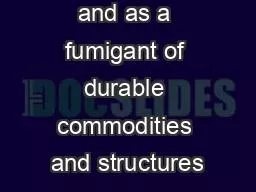

Link MBTOC98pdf United Nations Environment Programme Industry and Environment 1998 OzonAction httpwwwunepfrozonactioninformationmmcfiles2294epdf Additional Review Articles Rosskopf Erin N D ID: 892905
Download Pdf The PPT/PDF document "soil fumigant and as a fumigant of durab..." is the property of its rightful owner. Permission is granted to download and print the materials on this web site for personal, non-commercial use only, and to display it on your personal computer provided you do not modify the materials and that you retain all copyright notices contained in the materials. By downloading content from our website, you accept the terms of this agreement.
1 soil fumigant and as a fumigant of durab
soil fumigant and as a fumigant of durable commodities and structures; and approved and potential alternatives for quarantine and pre-shipment treatments, including treatments for perishables. It also shows trends in methyl bromide production and consumption in both Article 5 and non-Article 5 Parties, estimated levels of emissions of MB to the atmosphere, and strategies to reduce those emissions. In addition, the report describes critical uses of MB that have been approved by the Parties for 2005 onwards and on economic issues influencing MB phase-out. Link: MBTOC2006.pdf United National Environment Programme, Division of Technology, Industry and Economics, OzonAction Programme. 2000. Case Studies on Alternatives to Methyl Bromide: Technologies with Low Environmental Impact. United Nations Publications. Abstract: Achieving the methyl bromide phase out is one of the last remaining challenges for ozone-layer protection. Since 1997, the search for alternative techniques has been on-going. This publication documents 18 worldwide case studies that illustrate non-chemical alternative techniques successfully used for major crops/commodities. Each case study presents information on the alternative technique; comparison of Link: MBTOC98.pdf United Nations Environment Programme, Industry and Environment. 1998. OzonAction http://www.unep.fr/ozonaction/information/mmcfiles/2294-e.pdf Additional Review Articles Rosskopf, Erin N.,
2 Daniel O. Chellemi, Nancy Kokalis-Burel
Daniel O. Chellemi, Nancy Kokalis-Burell, and Gregory T. Church, Pierce, FL 34945. Plant Management Network. 27 October 2005 Abstract: The first use of methyl bromide as a soil fumigant occurred in France in the 1930s (7). Since its discovery and implementation, methyl bromide has been consistently effective for control of nematodes, fungi, insects and weeds and has been used on more than 100 crops worldwide. Methyl bromideÕs high vapor pressure allows for rapid and thorough distribution through the soil, enhancing its effectiveness as a fumigant. The high vapor pressure also facilitates a relatively short plant-back interval and gives growers a great degree of flexibility. For nearly four decades, methyl bromide has been the fumigant most heavily relied upon for pre-plant soil treatment for the production of vegetables and ornamentals. The world's largest consumer of methyl bromide is the United States, where the majority of use (83%) is for pre-plant soil fumigation (119). Other uses include post-harvest treatment of stored commodities (11%) and structural fumigation (6%). Based on 1997 U.S. consumption records, 36% of pre-plant methyl bromide use took place in Florida crop production systems, with strawberry, pepper and tomato accounting for 9, 23, and 62% of the soil fumigation uses in the state (84). Methyl bromide is considered essential for the production of eggplant, pepper, strawberry, watermelon and tomato in many l
3 ocations (41,42,124). The nursery indust
ocations (41,42,124). The nursery industry accounts for nine percent of the U.S. pre-plant consumption of methyl bromide for the production of potted plants, cut flowers, ornamental nursery plants, fruit and tree nursery plants, sod, bulbs, strawberry and vegetable transplants (118). Within the floriculture industry, there are few statistics on methyl bromide use by individual crops, although certain segments such as the field production of chrysanthemum, caladium, and gladiola rely heavily on its use as a soil fumigant (57). Link:http://www.apsnet.org/online/feature/methylb systems which begin with pre-plant management decisions and continue through post-harvest processing. Published in 2003 for SCI by John Wiley & Sons, Ltd. Link: http://www3.interscience.wiley.com/cgi-bin/abstract/104534536/ABSTRACTMartin, F. N., and Bull, C. T. 2002. Biological approaches for control of some root pathogens of strawberry. Phytopathology 92:1356-1362. Abstract: Soil fumigation with methyl bromide plus chloropicrin is used as a preplant treatment to control a broad range of pathogens in high-value annual crop production systems. In California, fumigation is used on approximately 10,125 ha of strawberry production to control pathogens ranging from Verticillium dahliae to root pruning pathogens such as Pythium, Rhizoctonia, or Cylindrocarpon spp. In addition to pathogen control, fumigation also causes an enhanced growth response of the plant an
4 d reduces weed pressure. The development
d reduces weed pressure. The development of successful, long-term cost effective biocontrol strategies most likely will require the development of an integrated systems approach that incorporates diverse aspects of the crop production system. Although application of single microbial inoculants may provide some level of control for specific production problems, it will be a challenge to provide the broad spectrum of activity needed in production fields. Link:http://apsjournals.apsnet.org/doi/pdf/10.1094/PHYTO.2002.92.12.1356 Salles, L.A., D.A. Sosa and A. Valeiro. 2001. Alternatives for the Replacement of Methyl Bromide in Argentina. Global report on validated alternatives to the use of methyl bromide for soil fumigation-summaries. Abstract: The cultivation of strawberry, tomato, cut flowers and tobacco was considered. Strawberry is an economically important crop in Argentina. The amount of land devoted to the cultivation of strawberry varies depending on the region. The use of Methyl Bromide (MeBr) allows to protect the crop from the attack of several soil-borne pests. Several experiences have been carried out to validate already tested alternatives and to adapt them to local conditions for the replacement of MeBr. For this purpose, different chemical fumigants were compared. Dazomet and metam sodium were the fumigants compared for the control of soil-borne fungi, nematodes, insects and weeds. Both products came out as viab